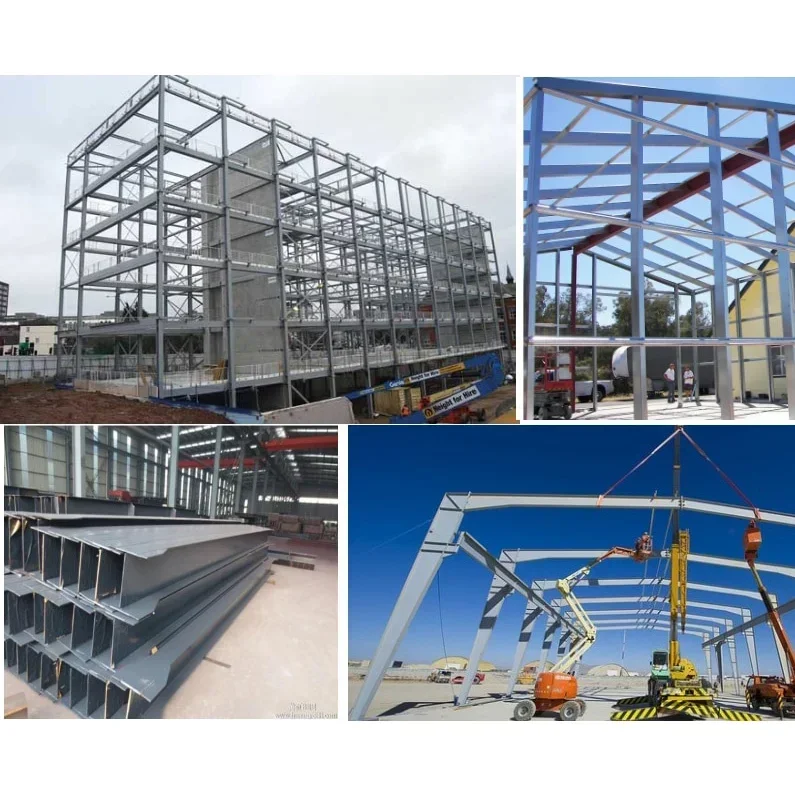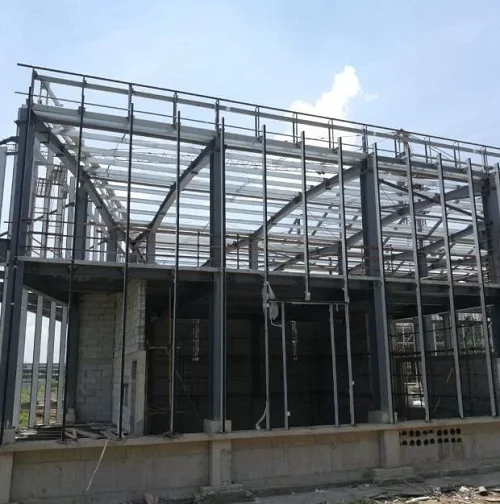Discover the key elements of constructing a steel structure factory building efficiently. From cost-effective design considerations to durability advantages, this blog post delves into essential aspects for your project's success. Explore how steel structures offer flexibility, sustainability, and rapid construction benefits compared to traditional building materials. Learn about the customization options available to tailor the factory layout to your specific operational needs. Uncover the environmental benefits of steel structures and how they contribute to eco-friendly construction practices.
Advantages of Steel structure factory building
Durability
Steel structure factory buildings are known for their exceptional durability, providing long-term reliability for industrial operations. The robust nature of steel ensures that the building can withstand harsh weather conditions and external pressures.
Steel structures have a high strength-to-weight ratio, making them ideal for supporting heavy industrial equipment and machinery. This feature allows for the construction of large, open spaces within the factory building without the need for numerous support columns.
Cost-Effectiveness
One significant advantage of steel structure factory buildings is their cost-effectiveness. Compared to traditional construction materials, such as concrete or wood, steel offers a more economical option in terms of both initial construction costs and long-term maintenance expenses.
Steel structures are quick to assemble due to their prefabricated components, resulting in faster construction times. This efficiency not only reduces labor costs but also allows businesses to start operations sooner, leading to quicker returns on investment.
Flexibility
The versatility of steel structure factory buildings makes them highly adaptable to various industrial requirements. Whether expanding the existing facility or reconfiguring the interior layout, steel structures offer ease of modification without compromising structural integrity.
Steel buildings can accommodate different architectural designs and layouts, providing customization options tailored to specific manufacturing processes. This flexibility enables industries to optimize space utilization and workflow efficiency within the factory premises.
Designing Your Steel Factory Building
Proper Layout Planning
Proper layout planning is crucial for workflow efficiency in a steel structure factory building. A well-thought-out layout ensures seamless movement of materials, equipment, and workers. It minimizes bottlenecks and enhances productivity.
Efficient layout planning involves strategically placing workstations, storage areas, and machinery to optimize the workflow. By minimizing unnecessary movement and congestion, productivity can be significantly increased.
Natural Light and Ventilation
Incorporating natural light and ventilation into the design of a steel factory building offers numerous benefits. Natural light not only reduces energy costs but also creates a more comfortable working environment for employees.
Adequate ventilation helps regulate indoor air quality, preventing the buildup of pollutants and ensuring a healthy workspace. By harnessing natural elements like sunlight and fresh air, the overall well-being of workers can be improved.
Scalability and Future Expansion
Considering scalability and future expansion during the design process is essential for a steel structure factory building. As businesses grow, the need for additional space may arise. Designing with scalability in mind allows for easy modifications and expansions in the future.
Optimizing Floor Heights and Spans
Productivity Impact
Floor heights significantly influence productivity in a steel structure factory building. Higher floor heights allow for better ventilation, creating a more comfortable working environment. This leads to increased productivity among employees due to improved air quality and overall comfort. Higher ceilings enable the installation of larger equipment, optimizing the manufacturing process.
Benefits of Wide Spans
Wide spans play a crucial role in maximizing space utilization within a steel structure factory building. They facilitate open floor plans, providing flexibility in layout design and machinery placement. With wide spans, manufacturers can efficiently organize workstations and production lines, enhancing workflow and operational efficiency.
Safety Considerations
When optimizing floor heights and spans, it is essential to prioritize safety considerations. Proper structural engineering is vital to ensure that the building can withstand heavy machinery loads and other equipment. Adequate support through strategically placed columns is necessary to maintain the stability of the structure. Regular inspections and maintenance routines are crucial to prevent any potential safety hazards.
Understanding Different Steel structure factory building
Types
Steel factories can be classified into various types based on their design and purpose. Common categories include heavy industrial factories for manufacturing heavy machinery, light industrial factories for producing consumer goods, and specialized structure for specific industries like automotive or aerospace.
Steel frame structures are widely used in modern factory construction due to their durability, flexibility, and cost-effectiveness. These structures consist of columns, beams, and trusses made of steel components designed to support the building's weight and withstand external forces.
Benefits
-
Durability: Steel is known for its strength and resilience, making it an ideal choice for constructing long-lasting factory buildings.
-
Flexibility: Steel structures can easily be modified or expanded to accommodate changing production needs without compromising the building's integrity.
-
Cost-Effective: Despite the initial investment, steel frame factories require less maintenance over time, reducing long-term costs.
Steel structure factory buildings offer excellent resistance to fire hazards due to the material's non-combustible nature. This feature ensures a safer working environment for employees and protects valuable equipment and inventory from potential damage.
Design Considerations
When planning a steel structure factory building, several key factors need to be considered:
-
Load-Bearing Capacity: The design must account for the maximum load the structure will bear during operations.
-
Foundation Stability: Ensuring a solid foundation is crucial to support the entire building and prevent structural issues over time.
-
Roofing Options: Selecting the right roofing material is essential for weather protection and energy efficiency in the facility.
-
Ventilation Systems: Proper ventilation plays a critical role in maintaining air quality and regulating temperatures inside the factory.
To enhance productivity and efficiency within a steel structure factory building, optimizing layout design is essential. Efficient floor plans that streamline workflow processes can lead to increased production output and smoother operations.
Durability and Clear Span Benefits
Maintenance
Steel structure factory buildings are known for their durability against harsh weather conditions and wear. The low maintenance requirements of steel structures make them a popular choice for industrial spaces. Regular inspections can help identify and address any potential issues promptly.
Corrosion
One of the key benefits of steel structures is their resistance to corrosion. This resistance ensures that the building remains structurally sound over an extended period, reducing the need for frequent repairs or replacements. Proper coatings can further enhance the longevity of the steel components.
Options
When it comes to designing a steel structure factory building, there are various options available to meet specific needs. From choosing the right steel grade to selecting custom features like insulation and cladding, these options allow for customization based on functional requirements and aesthetic preferences.
Wind
Steel buildings are designed to withstand various environmental factors, including strong wind loads. The inherent strength of steel makes it ideal for withstanding high winds without compromising the structural integrity of the building. This resilience ensures long-term protection against wind-related damage.
Steel structures with clear span designs offer significant advantages in maximizing interior space utilization. By eliminating the need for internal support columns, clear span structures provide uninterrupted floor space, allowing for flexible layout arrangements and efficient workflow operations. Clear span designs facilitate easy machinery installation and movement within the building, enhancing operational efficiency.
The durability of steel structure factory buildings translates into long-term cost savings for owners. With minimal maintenance requirements and resistance to corrosion, owners can reduce repair and replacement costs over the building's lifespan. Moreover, the robust nature of steel structures minimizes downtime due to structural issues, contributing to overall productivity and profitability.

Summary
The comparison between steel and traditional buildings highlights the numerous advantages of opting for a steel structure factory building. From enhanced durability to clear span benefits, steel structures offer a superior choice for those seeking a reliable and efficient factory building solution. Design considerations such as optimizing floor heights and spans play a crucial role in maximizing the functionality and productivity of the space.
Understanding the different types of steel structures available further empowers decision-making in constructing a tailored factory building. As industries evolve, embracing the versatility and sustainability of steel structures can lead to long-term cost savings and operational efficiencies. For those considering a new factory building or upgrading an existing one, delving into the realm of steel structures promises a future-ready solution that aligns with modern industrial needs.
Frequently Asked Questions
What are the key differences between steel and traditional buildings?
Steel buildings offer faster construction, higher durability, and better sustainability compared to traditional buildings. Traditional buildings may have more design flexibility but are generally slower and costlier to build.
What are the advantages of choosing a steel structure for a factory building?
Steel structures provide excellent strength-to-weight ratio, allowing for larger open spaces without the need for internal support columns. They are also durable, cost-effective, and eco-friendly in terms of recyclability.
How can one optimize floor heights and spans when designing a steel factory building?
By carefully planning the layout and considering the load requirements of different areas within the building, architects and engineers can optimize floor heights and spans to maximize space utilization while ensuring structural integrity.
What types of steel structures are commonly used in factory buildings?
Common types include clear span rigid frames, modular frames, single slope frames, and lean-to frames. Each type offers specific benefits in terms of cost-effectiveness, flexibility in design, and ease of construction.
What are the durability and clear span benefits associated with steel structure factory buildings?
Steel structures are highly durable against environmental factors like corrosion, pests, and fire. Clear span designs eliminate the need for interior support columns, providing unobstructed floor space for efficient layout planning.

